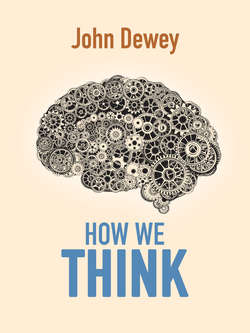How We Think

Реклама. ООО «ЛитРес», ИНН: 7719571260.
Оглавление
John Dewey. How We Think
PREFACE
PART ONE: THE PROBLEM OF TRAINING THOUGHT
CHAPTER ONE. WHAT IS THOUGHT?
CHAPTER TWO. THE NEED FOR TRAINING THOUGHT
CHAPTER THREE. NATURAL RESOURCES IN THE TRAINING OF THOUGHT
CHAPTER FOUR. SCHOOL CONDITIONS AND THE TRAINING OF THOUGHT
CHAPTER FIVE. THE MEANS AND END OF MENTAL TRAINING: THE PSYCHOLOGICAL AND THE LOGICAL
PART TWO: LOGICAL CONSIDERATIONS
CHAPTER SIX. THE ANALYSIS OF A COMPLETE ACT OF THOUGHT
CHAPTER SEVEN. SYSTEMATIC INFERENCE: INDUCTION AND DEDUCTION
CHAPTER EIGHT. JUDGMENT: THE INTERPRETATION OF FACTS
CHAPTER NINE. MEANING: OR CONCEPTIONS AND UNDERSTANDING
CHAPTER TEN. CONCRETE AND ABSTRACT THINKING
CHAPTER ELEVEN. EMPIRICAL AND SCIENTIFIC THINKING
PART THREE: THE TRAINING OF THOUGHT
CHAPTER TWELVE. ACTIVITY AND THE TRAINING OF THOUGHT
CHAPTER THIRTEEN. LANGUAGE AND THE TRAINING OF THOUGHT
CHAPTER FOURTEEN. OBSERVATION AND INFORMATION IN THE TRAINING OF MIND
CHAPTER FIFTEEN. THE RECITATION AND THE TRAINING OF THOUGHT
CHAPTER SIXTEEN. SOME GENERAL CONCLUSIONS
INDEX
Отрывок из книги
Our schools are troubled with a multiplication of studies, each in turn having its own multiplication of materials and principles. Our teachers find their tasks made heavier in that they have come to deal with pupils individually and not merely in mass. Unless these steps in advance are to end in distraction, some clew of unity, some principle that makes for simplification, must be found. This book represents the conviction that the needed steadying and centralizing factor is found in adopting as the end of endeavor that attitude of mind, that habit of thought, which we call scientific. This scientific attitude of mind might, conceivably, be quite irrelevant to teaching children and youth. But this book also represents the conviction that such is not the case; that the native and unspoiled attitude of childhood, marked by ardent curiosity, fertile imagination, and love of experimental inquiry, is near, very near, to the attitude of the scientific mind. If these pages assist any to appreciate this kinship and to consider seriously how its recognition in educational practice would make for individual happiness and the reduction of social waste, the book will amply have served its purpose.
It is hardly necessary to enumerate the authors to whom I am indebted. My fundamental indebtedness is to my wife, by whom the ideas of this book were inspired, and through whose work in connection with the Laboratory School, existing in Chicago between 1896 and 1903, the ideas attained such concreteness as comes from embodiment and testing in practice. It is a pleasure, also, to acknowledge indebtedness to the intelligence and sympathy of those who coöperated as teachers and supervisors in the conduct of that school, and especially to Mrs. Ella Flagg Young, then a colleague in the University, and now Superintendent of the Schools of Chicago.
.....
So far there is the same sort of situation as when one looking at a cloud is reminded of a human figure and face. Thinking in both of these cases (the cases of belief and of fancy) involves a noted or perceived fact, followed by something else which is not observed but which is brought to mind, suggested by the thing seen. One reminds us, as we say, of the other. Side by side, however, with this factor of agreement in the two cases of suggestion is a factor of marked disagreement. We do not believe in the face suggested by the cloud; we do not consider at all the probability of its being a fact. There is no reflective thought. The danger of rain, on the contrary, presents itself to us as a genuine possibility—as a possible fact of the same nature as the observed coolness. Put differently, we do not regard the cloud as meaning or indicating a face, but merely as suggesting it, while we do consider that the coolness may mean rain. In the first case, seeing an object, we just happen, as we say, to think of something else; in the second, we consider the possibility and nature of the connection between the object seen and the object suggested. The seen thing is regarded as in some way the ground or basis of belief in the suggested thing; it possesses the quality of evidence.
Various synonymous expressions for the function of signifying
.....